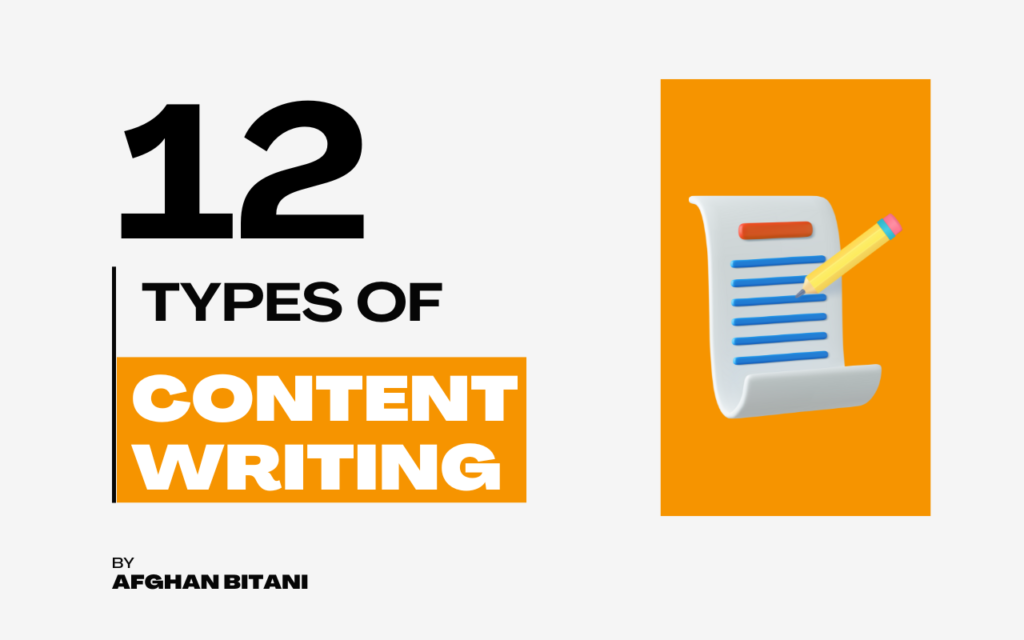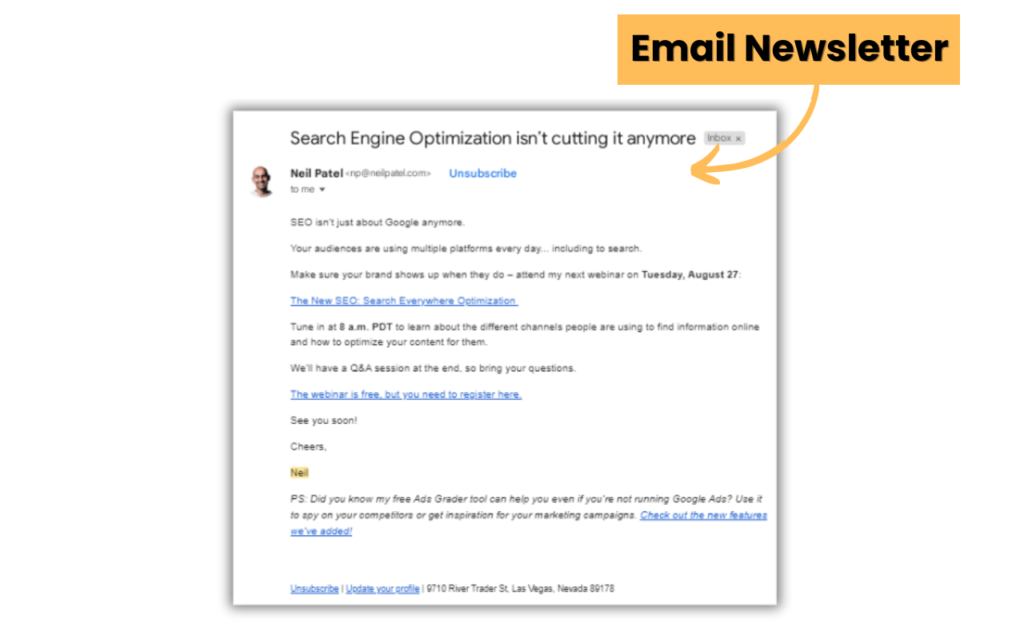
Content comes in numerous forms, each tailored to specific audiences, platforms, and objectives. With the high growth of digital marketing, understanding these different types of content writing is essential for anyone looking to build a robust online presence.
Each type of content writing is important for giving customers and prospects the information they need. While written content is still the most common way to communicate, understanding the differences between each type helps you succeed in content marketing.
This guide will analyze 12 key types of content writing, each serving unique purposes in your marketing strategy.
Table of Contents
Types of Content Writing
1. Blog Posts
Blog posts are perhaps the most versatile and widely-used form of content in the digital space. They are essential for driving traffic, establishing authority, and engaging with your audience.
A blog post allows for the exploration of a topic in-depth, typically ranging from 1,200 to 2,500 words. Businesses publish these articles in the blog section of their website, often focusing on topics related to their industry. This approach not only helps in providing valuable information to their audience but also significantly boosts their website’s SEO.
According to HubSpot, companies that blog get 55% more website visitors than those that don’t. Blogging can be a powerful strategy to gain new audiences, as most people search for topics through search engines. This gives businesses an excellent opportunity to use SEO to their advantage, increasing their website’s visibility and, consequently, brand awareness.
Types of Blog Posts:
- How-to Guides: Step-by-step instructions on how to achieve a specific goal.
- Listicles: Curated lists of tips, tools, or resources.
- Expanded Definition Posts: In-depth explanations of complex concepts.
- Templates and Checklists: Ready-made tools to help readers accomplish tasks.
- Reports or Statistics: Data-driven posts offering insights into industry trends.
Example: Growjani blog is a prime example of using blog posts to cover topics related to social media marketing, helping them establish authority in their niche.
Pro Tip: Incorporate AI writing tools like Semrush ContentShake Ai to generate SEO-optimized articles in minutes, allowing you to scale your content creation efforts without compromising on quality.
Interested to learn more about how to write a perfect blog post? Here is our complete blog.
2. Website Copywriting
Website copywriting involves crafting content for key pages on a website, including landing pages, product pages, home pages, and more. The goal is to communicate clearly and engage visitors to take actionable steps, such as making a purchase or signing up for a service.
Effective website copy is concise and persuasive, providing visitors with all the information they need to make informed decisions. A great company website should include essential pages like the homepage, About Us, product/service pages, and contact information.
A study by Nielsen Norman Group found that people only read about 20-28% of the words on a webpage. Therefore, website copy must be compelling enough to capture attention quickly.
Essential Pages for Effective Website Copy:
- Homepage: Offers a snapshot of what the company does and its unique value proposition.
- About Us: Builds trust by sharing the company’s story, mission, and values.
- Product/Services Page: Details the benefits and features of the offerings.
- Contact Page: Provides easy ways for visitors to get in touch with the company.
Example: Trello’s Home page effectively communicates its value proposition in a simple, easy-to-understand sentence, encouraging visitors to explore further.

Pro Tip: Employ conversion copywriting techniques to enhance website engagement. Techniques like PAS (Problem, Agitate, Solution) or AIDA (Attention, Interest, Desire, Action) can significantly improve the effectiveness of your website copy.
3. Advertising and Sales Copywriting
Advertising and sales copywriting is at the core of any marketing campaign, aiming to grab the audience’s attention and persuade them to take action, whether it’s making a purchase, signing up for a newsletter, or registering for a webinar.
Sales copy is often found in ads, brochures, sales pages, and promotional emails. The primary goal is to convert readers into customers by appealing to their emotions and desires.
According to a study by the Direct Marketing Association, email marketing, which heavily relies on sales copy, yields an average ROI of $42 for every $1 spent. This highlights the importance of well-crafted sales copy in driving business growth.
Common Sales Copy Techniques:
- PAS (Problem, Agitate, Solution): Identify the problem, amplify it, and offer a solution.
- AIDA (Attention, Interest, Desire, Action): Guide the reader through a series of steps leading to a purchase.
- FAB (Features, Advantages, Benefits): Highlight what makes the product unique and how it benefits the user.
Example: Monday, a work management platform, uses emotional triggers in its ad copy to resonate with potential customers, promising improved productivity.
Pro Tip: Use data and psychology to enhance the effectiveness of your sales copy. Understanding your audience’s pain points and desires allows you to craft messages that resonate deeply, increasing conversion rates.
4. Technical Writing
Technical writing is specialized content designed to explain complex processes or concepts in industries such as science, engineering, medicine, and finance. This type of writing requires a deep understanding of the subject matter and the ability to communicate it clearly and concisely.
Technical content often includes documentation, user manuals, white papers, and reports. The audience is typically professionals within the industry, making accuracy and detail paramount.
According to a report by the Bureau of Labor Statistics, the demand for technical writers is expected to grow by 7% from 2019 to 2029, faster than the average for all occupations. This reflects the increasing need for clear and precise communication in technical fields.
Common Types of Technical Writing:
- Technical Documentation: Detailed guides for using or developing products.
- Reports: In-depth analysis of specific industry topics.
- User Manuals: Step-by-step instructions for operating products.
- White Papers: Authoritative reports on complex topics.
Example: Stripe’s developer documentation is a prime example of technical writing that effectively communicates complex information to a targeted audience.
Pro Tip: Ensure that your technical writing is not only accurate but also accessible. Use visuals, diagrams, and examples to help clarify complex concepts, making the content more engaging and easier to understand.
5. Social Media Posts

Social media writing is unique in that it must be short, engaging, and tailored to the specific platform. The primary goal is to engage the audience, build brand personality, and drive interaction.
Different platforms require different approaches. For instance, Facebook and LinkedIn are more suited for longer posts, while Instagram, TikTok, and Pinterest focus on visual content with concise captions.
Social media platforms have over 4.7 billion users worldwide, making them a critical channel for businesses to connect with their audience. The key is to create content that resonates with the platform’s users while staying true to your brand voice.
Social Media Platform Specifics:
- Facebook: Allows for longer posts with more in-depth content.
- Instagram: Focuses on visual content with short, impactful captions.
- LinkedIn: Professional content that adds value to the reader’s career or industry knowledge.
- Twitter/X: Short, snappy content that encourages conversation.
Example: Starbucks’ Instagram posts showcase their products while tapping into trends and engaging with their audience through visually appealing content.
Pro Tip: Use a mix of content formats on social media, including images, videos, polls, and stories, to keep your audience engaged. Track your social media metrics to understand what type of content resonates most with your audience.
6. Ebooks and White Papers
Ebooks and white papers are long-form content pieces designed to showcase expertise and provide in-depth insights into specific topics. They are often used in B2B marketing strategies to generate leads and establish thought leadership.
Ebooks typically range from 10,000 to 20,000 words and can cover various topics, from how-to guides to detailed industry analyses. White papers, on the other hand, are more formal and research-oriented, often used to present solutions to complex problems.
According to the Content Marketing Institute, 71% of B2B marketers use ebooks and white papers as part of their content strategy, highlighting their importance in building authority and generating leads.
Uses of Ebooks and White Papers:
- Lead Generation: Offer ebooks and white papers in exchange for contact information.
- Thought Leadership: Demonstrate expertise in a particular field.
- Education: Provide in-depth knowledge on complex topics.
Example: Gartner’s ebooks are a prime example of using long-form content to demonstrate expertise and provide valuable insights to their audience.
Pro Tip: Ensure that your ebooks and white papers are well-researched and offer unique insights. Include data, case studies, and expert quotes to enhance credibility and value.
7. Case Studies
Case studies provide real-world examples of how your product or service has helped clients achieve their goals. They serve as powerful tools for building credibility and trust with potential customers.
A well-written case study should focus on the client’s problem, the solution you provided, and the results achieved. It’s essential to be detailed and provide actionable insights that potential customers can relate to.
According to the Demand Gen Report, 79% of B2B buyers refer to case studies when making purchasing decisions. This underscores the importance of using case studies to showcase your product’s effectiveness.
Key Elements of a Case Study:
- Client Background: Provide context on who the client is and what they do.
- Problem: Explain the challenge the client was facing.
- Solution: Detail how your product or service addressed the problem.
- Results: Quantify the impact of your solution with data and metrics.
Example: HubSpot’s case studies demonstrate how their CRM solutions have helped businesses streamline their operations and achieve significant growth.
Pro Tip: Use visual elements like charts, graphs, and images in your case studies to make the content more engaging and easier to understand. Include client testimonials to add an extra layer of credibility.
8. Email Newsletters

Email newsletters are a direct line of communication between a brand and its audience. They serve as a means to keep subscribers informed, engaged, and connected to the brand. Newsletters can include a variety of content, such as blog post summaries, product updates, promotional offers, and industry news.
Email marketing continues to be one of the most effective digital marketing channels. According to Statista, the global number of email users is expected to reach 4.6 billion by 2025, emphasizing the vast potential of email marketing.
Types of Email Newsletters:
- Promotional Emails: Focused on sales and special offers.
- Content Roundups: Summaries of recent blog posts, articles, or news.
- Product Updates: Inform subscribers about new features or products.
- Event Invitations: Encourage participation in webinars, conferences, or workshops.
Example: Airbnb’s email newsletters effectively use personalized content and visually appealing designs to engage their subscribers and keep them informed about relevant offerings.
Pro Tip: Personalization is key to effective email newsletters. Use segmentation to send targeted content based on subscriber interests, behavior, or demographics. Incorporate engaging visuals and strong CTAs to drive action.
9. Product Descriptions

Product descriptions are short, compelling texts that highlight the features and benefits of a product. The goal is to persuade potential customers to make a purchase by clearly communicating the product’s value.
A well-crafted product description goes beyond listing features; it connects with the customer on an emotional level, addressing their needs and desires. According to a study by Salsify, 87% of shoppers consider detailed product content a critical factor in their purchase decision.
Elements of an Effective Product Description:
- Features: Highlight the key attributes of the product.
- Benefits: Explain how the product will improve the customer’s life.
- Use Cases: Provide examples of how the product can be used.
- Call to Action: Encourage the customer to make a purchase.
Example: Apple’s product descriptions are known for being concise, clear, and focused on the benefits of their products, making them a benchmark in the industry.
Pro Tip: Use bullet points to break down features and benefits, making the product description easier to scan. Include high-quality images and videos to complement the text and provide a more immersive experience.
10. Press Releases
Press releases are official statements issued to the media to announce newsworthy events, such as product launches, mergers, or major achievements. They are designed to garner media attention and generate public interest.
A press release should be concise, factual, and formatted according to industry standards. It typically includes a headline, a brief summary, the main body, and contact information for further inquiries.
According to Cision’s 2020 State of the Media Report, 69% of journalists say they prefer receiving press releases, emphasizing their importance in the news cycle.
Components of a Press Release:
- Headline: A catchy title that summarizes the news.
- Summary: A brief overview of the main points.
- Body: Detailed information about the announcement.
- Quotes: Statements from key stakeholders or experts.
- Contact Information: Details for media inquiries.
Example: Tesla’s press releases effectively communicate their latest innovations and developments, helping them maintain a strong presence in the media.
Pro Tip: Tailor your press releases to the specific audience you’re targeting. Ensure that the content is newsworthy and that you have a clear angle that will interest journalists.
11. Video Scripts
Video scripts are the written blueprints for video content, guiding the narrative, dialogue, and visual elements. A well-structured script ensures that the video is engaging, informative, and aligned with the brand’s goals.
With the growing popularity of video content, having a well-crafted script is essential for producing high-quality videos that resonate with your audience. According to Wyzowl, 86% of businesses use video as a marketing tool, underscoring the importance of effective video scripts.
Types of Video Scripts:
- Explainer Videos: Simple, clear scripts that explain a product or service.
- Tutorial Videos: Step-by-step guides that educate viewers.
- Product Demos: Scripts that showcase the features and benefits of a product.
- Brand Videos: Stories that convey the brand’s values and mission.
Example: Dropbox’s explainer video script effectively communicates the benefits of their service in a simple and relatable way, making it one of the most successful explainer videos of all time.
Pro Tip: Focus on storytelling in your video scripts. A compelling narrative can capture the viewer’s attention and make the content more memorable. Use a conversational tone to make the script more engaging.
12. SEO Writing
SEO writing is the practice of crafting content that is optimized for search engines. The goal is to improve the visibility of a website by targeting specific keywords and phrases that potential customers are likely to search for.
SEO writing involves more than just stuffing keywords into a text. It requires a deep understanding of search engine algorithms, user intent, and on-page SEO factors. According to BrightEdge, organic search drives 53% of all website traffic, making SEO writing a critical component of any content strategy.
Interested to read more about SEO writing? Here is our complete blog on “How To Write an SEO Blog Post“
Key SEO Writing Techniques:
- Keyword Research: Identifying the terms your audience is searching for.
- On-Page Optimization: Using keywords naturally in headings, meta descriptions, and content.
- Content Structure: Organizing content with headings, subheadings, and bullet points for readability.
- Internal Linking: Linking to other relevant pages on your website.
Example: Moz’s blog is a great example of SEO writing. Their posts are informative, well-structured, and optimized for search engines, helping them rank highly for relevant keywords.
Pro Tip: Keep up with the latest SEO trends and algorithm updates. Search engines are constantly evolving, and staying informed will help you maintain your rankings. Use tools like SEMrush or Ahrefs to track your SEO performance and identify opportunities for improvement.
Conclusion
Content writing is more than just putting words on a page. Each type of content serves a specific purpose and plays a crucial role in driving your overall marketing strategy. Whether you’re writing blog posts to build authority, crafting product descriptions to drive sales, or developing video scripts to engage your audience, understanding the nuances of each type is key to success.
By mastering these 12 types of content writing, you can create a diverse and effective content strategy that meets the needs of your audience and drives business growth. Remember, quality content is the cornerstone of any successful marketing effort, so take the time to develop your writing skills and stay informed about the latest trends in the industry.
Pingback: What Does a Content Writer Do?
I would like to join advertising and sales copyright
I have really loved this ,,,,I would like to grow bigger and become the best content creator in the world.
This platform is amazing and wonderful , it builds someone’s skills ,, I’m happy to be here to explore more.